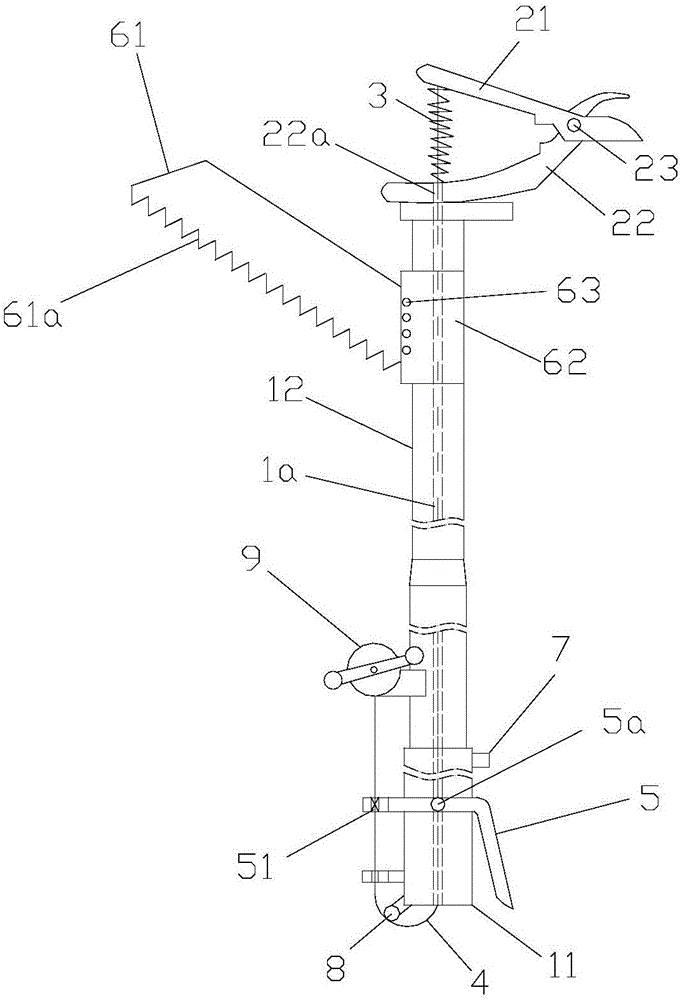Electrified pruning device
A technology of pruning and pruning, which is applied in the field of electrified pruning devices, can solve problems such as affecting normal power consumption of users, injury to staff, low work efficiency, etc., and achieves the effect of eliminating potential hidden dangers, reducing labor intensity and reducing weight.
- Summary
- Abstract
- Description
- Claims
- Application Information
AI Technical Summary
Problems solved by technology
Method used
Image
Examples
Embodiment 1
[0017] As shown in the figure: the live pruning device of the present embodiment includes an insulating rod, a scissors located on the insulating rod, a traction rope 4, an insulating handle 5 and a saw blade 61; The fixed blade 22 and the rotating shaft I23 hinged by the blade 21; the cutting edges of the movable blade 21 and the fixed blade 22 are curved in an arc shape, and the length of the blade end of the movable blade 21 is greater than the length of the blade end of the fixed blade 22; 21 and the scissor handle of the fixed blade 22 are provided with a return spring 3 for providing a reset force; the insulating rod is provided with an axial channel 1a, and the scissor handle of the fixed blade 22 is fixed on the top of the insulating rod and set There is a through hole 22a communicating with the axial passage 1a, one end of the traction rope 4 is connected with the insulating handle 5, and the other end is connected with the scissor handle of the movable blade 21 after ...
Embodiment 2
[0023] The electrified pruning device of this embodiment is structurally the same as that of the electrified pruning device in Embodiment 1, the only difference being the composition of the glass fiber material; in this embodiment, the glass fiber material includes the following components in parts by weight Divide: 31 parts of quartz sand, 10 parts of limestone, 5 parts of dolomite, 1 part of boric acid, 4 parts of Glauber's salt, 2 parts of fluorite, 1 part of pyrophyllite, 9 parts of alumina, and 10 parts of silicon dioxide. The materials of the above components are melted and sintered into 20mm rods or spheres, and then heated and remelted to make finer 3-60um fibers, and then the fibers are made into super-strong fiber rods by reverse winding with a roller machine or barrel. The material has high strength. After testing, the tensile strength of a single fine fiber can reach 2840Mpa, and the elastic modulus can reach 86000Mpa, which is several times higher than that of hig...
Embodiment 3
[0025] The electrified pruning device of this embodiment is structurally the same as that of the electrified pruning device in Embodiment 1, the only difference being the composition of the glass fiber material; in this embodiment, the glass fiber material includes the following components in parts by weight Divide: 35.5 parts of quartz sand, 13.5 parts of limestone, 9.5 parts of dolomite, 3.5 parts of boric acid, 7 parts of Glauber's salt, 5.5 parts of fluorite, 3 parts of pyrophyllite, 12 parts of alumina, and 12 parts of silicon dioxide. The materials of the above components are melted and sintered into 20mm rods or spheres, and then heated and remelted to make finer 3-60um fibers, and then the fibers are made into super-strong fiber rods by reverse winding with a roller machine or barrel. The material has high strength. After testing, the tensile strength of a single fine fiber can reach 2985Mpa, and the elastic modulus can reach 88500Mpa, which is several times higher tha...
PUM
 Login to View More
Login to View More Abstract
Description
Claims
Application Information
 Login to View More
Login to View More - R&D
- Intellectual Property
- Life Sciences
- Materials
- Tech Scout
- Unparalleled Data Quality
- Higher Quality Content
- 60% Fewer Hallucinations
Browse by: Latest US Patents, China's latest patents, Technical Efficacy Thesaurus, Application Domain, Technology Topic, Popular Technical Reports.
© 2025 PatSnap. All rights reserved.Legal|Privacy policy|Modern Slavery Act Transparency Statement|Sitemap|About US| Contact US: help@patsnap.com

